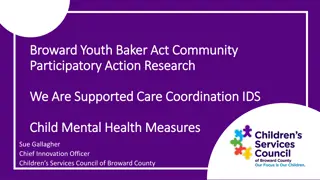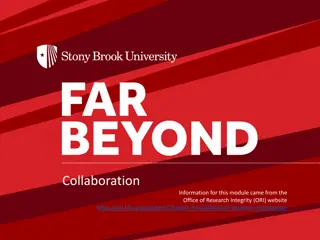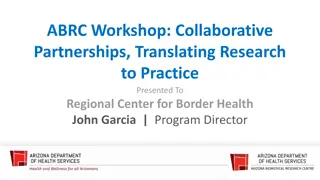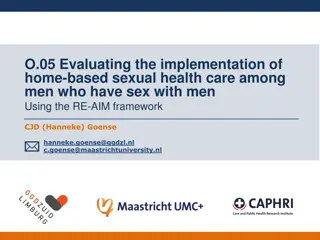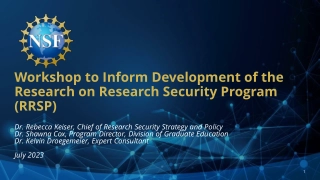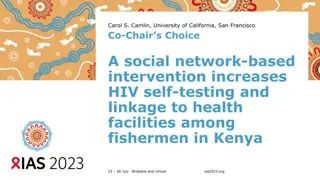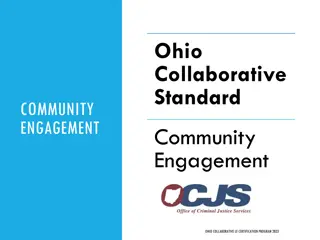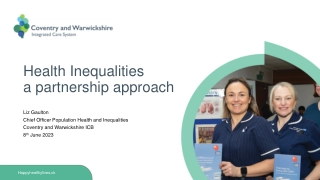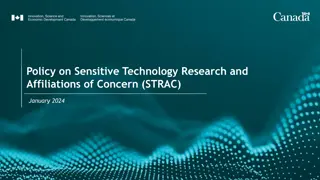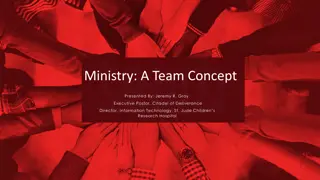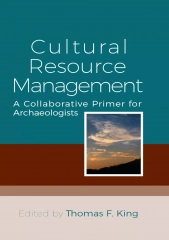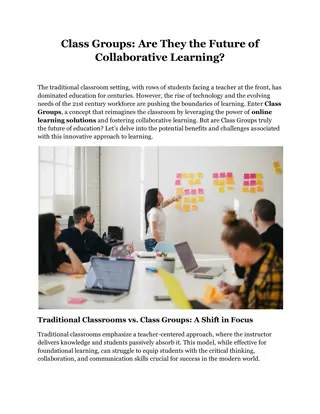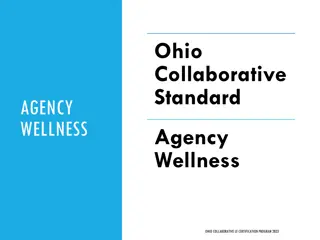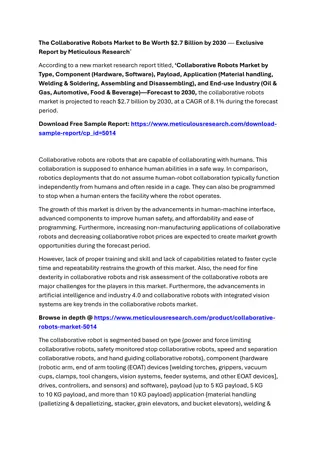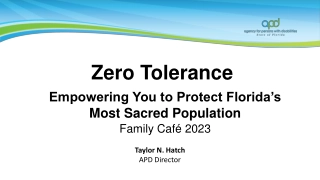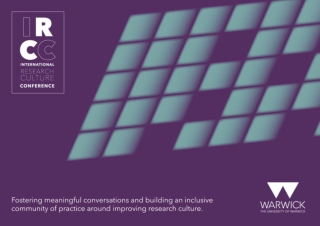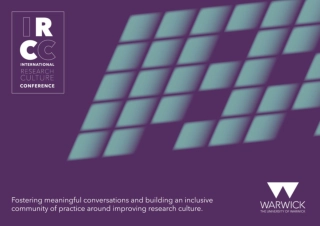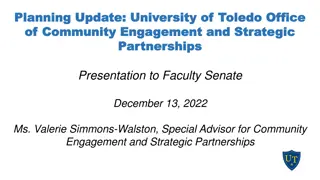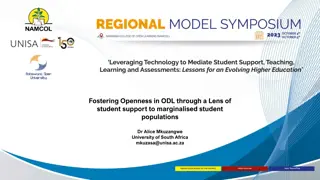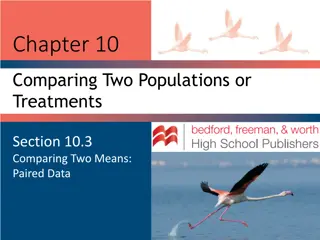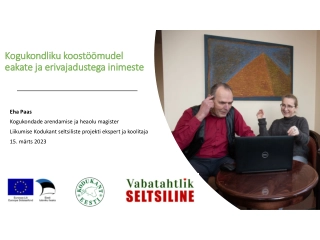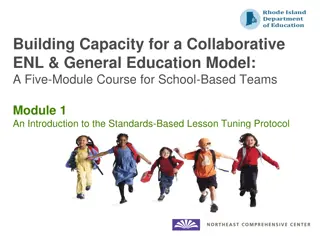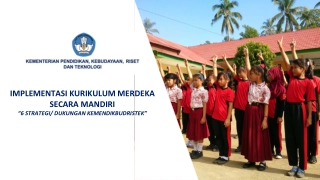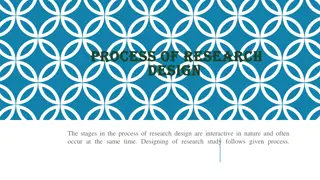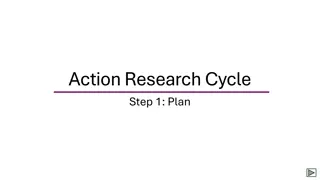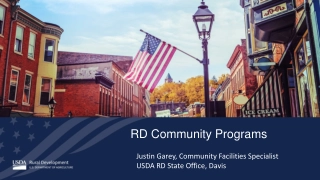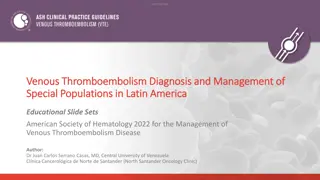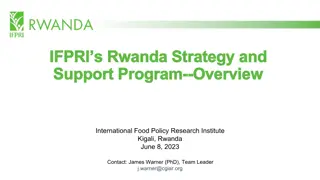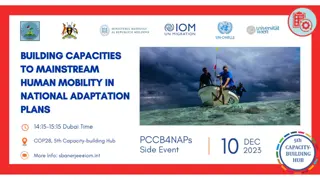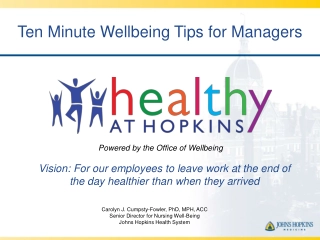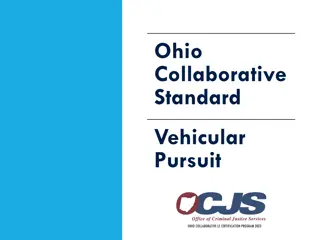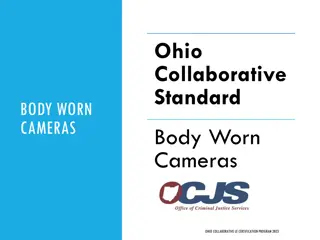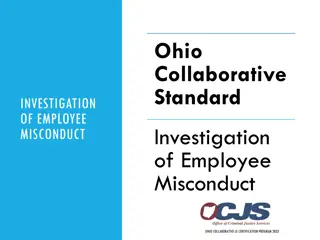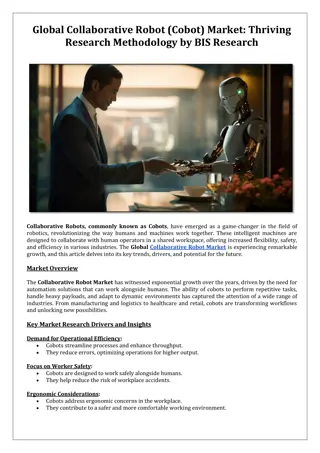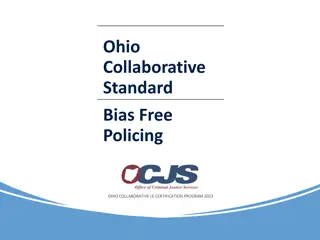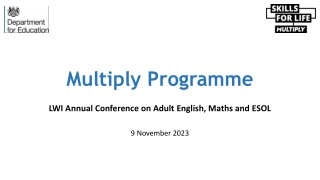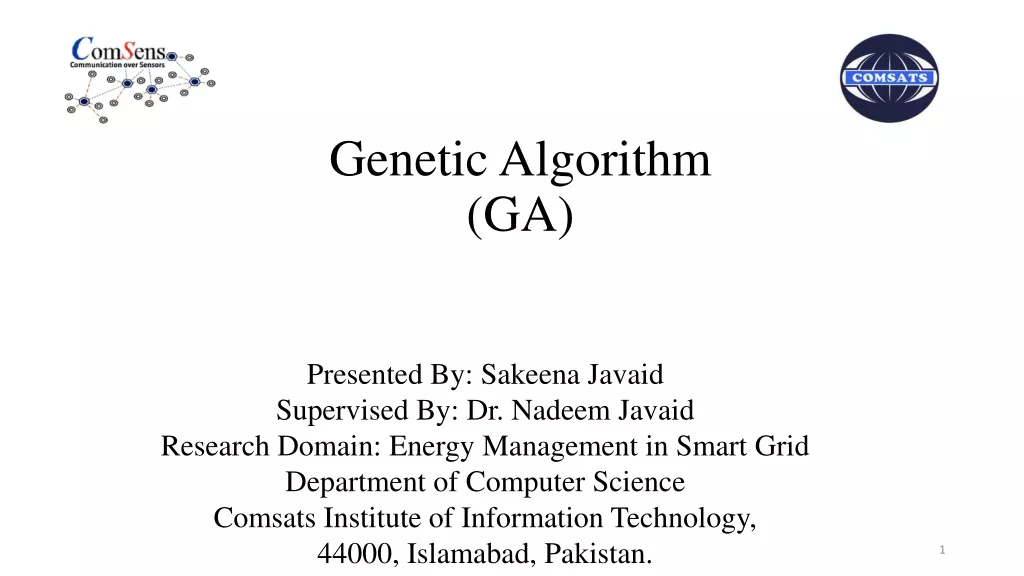Community-Based Participatory Research for Hard-to-Reach Populations: A Collaborative Approach
This presentation focuses on community-based participatory research for hard-to-reach populations, particularly on implementing harm reduction strategies for amphetamine-type stimulant (ATS) use. It addresses community engagement, outreach to hidden sites, societal perceptions of drug use, and the challenges faced by marginalized groups. The importance of involving diverse community advisory board members, developing harm reduction plans, and understanding the needs of hard-to-reach populations is highlighted.
Community-Based Participatory Research for Hard-to-Reach Populations: A Collaborative Approach
PowerPoint presentation about 'Community-Based Participatory Research for Hard-to-Reach Populations: A Collaborative Approach'. This presentation describes the topic on This presentation focuses on community-based participatory research for hard-to-reach populations, particularly on implementing harm reduction strategies for amphetamine-type stimulant (ATS) use. It addresses community engagement, outreach to hidden sites, societal perceptions of drug use, and the challenges faced by marginalized groups. The importance of involving diverse community advisory board members, developing harm reduction plans, and understanding the needs of hard-to-reach populations is highlighted.. Download this presentation absolutely free.
Presentation Transcript
COM M U NI T Y - B A SE D PA RT I CI PAT ORY R E SE A R CH F OR HA R D - T O- R E ACH POPUL ATI ONS: A PA RT NE R SHI P W I T H A N NGO N U R A F I Q A H M O H D S A L L E H , P H D D E P T. O F S O C I A L A N D P R E V E N T I V E M E D I C I N E , FAC U LT Y O F M E D I C I N E , U M C E N T R E O F E X C E L L E N C E F O R R E S E A R C H I N A I D S , U M I M O H D S A L L E H @ U M . E D U . M Y
OUTLINE 1.45 2.05: Community-based participatory research for hard-to reach populations (Iqa Mohd Salleh) (20mins) Q&A (5mins) 2.10 2.30: Promoting community engagement in implementation Science resources from the NIH and the HPTN (Sten Vermund) (20mins) Q&A (5mins) 2.35 2.55: Group Activity Small group discussion (20 mins) 2.55 3.15: Large group discussion & Conclusion (20 mins) Date
GROUP ACTIVITY (20 MINS) In recent years, there has been an increase in the number of amphetamine-type stimulants (ATS) use. The use of ATS can give rise to risky sexual behaviours, and the number of HIV and Hepatitis C infections. You are a part of a community advisory board that seeks to implement harm reduction for ATS use (i.e. safer smoking kits to prevent sharing). In your group, 1) Discuss members of the community advisory board. Who should you involve? How will each member contribute? 2) What is your positionality statement(s)? 3) What are your plans to implement harm reduction for ATS use. (i.e. Specific key Date activities)
Outreach work to one of the hidden sites where people are injecting drugs
Criminalization of drug use Moral model of drug use (Societal perceptions, poor lifestyle choice) Internal and external stigma Mistrust of the health care system Living on the margins of society WHY ARE THEY HIDDEN
WHO ARE HARD TO REACH POPULATIONS Ethnic/racial groups (e.g. Latino, Hispanics, Asian, or mixed) Substance abusers General - vulnerable , minority , disadvantaged Indigenous people Low income, disadvantaged area HIV (alone or with drug addiction or ethnic) Gay, lesbian, bisexual and transgender (LGBT) Low literacy group Homeless people High risk Youth Survivors of violence Sex workers Mental illness People with disability Resource: Lambert EY, Wiebel WW, editor.The Collection and Interpretation of Data from Hidden Populations.Washington, DC: United States National Institute on Drug Abuse; 1990. from http://www.drugabuse.gov/pdf/monographs/download98.html.[Google Scholar]
CHALLENGES WITH HEALTH RESEARCH Sampling: population-based probability sampling tends to be a time and cost inefficient strategy for sampling socially disadvantaged groups Participation: Low response rates in research due to mistrust in research or researcher, fear of authority; fear of being publicly exposed, particularly if they engaged in illegal behaviours Data collection: Language, lack of education and low literacy barriers may prohibit the collection of certain types of data such as self- administered survey data. Intervention delivery & uptake: interventions that do not align with the perceived needs or priorities of the targeted groups
OVERCOMING CHALLENGES Partnerships with local community- based organizations, non-governmental organizations help researchers gain access to an otherwise hard-to-reach groups; a reciprocal relationship in which community members and researchers have knowledge and learn from the other; community-initiated research projects that seek academic partnerships and use the outcomes to direct policy and program delivery.
SPECIFIC ROLES OF NGOS collaborate with community organizations with access to those groups to draw a convenience sample through NGOs; community groups can be involved in recruitment process engagement of local peer or known community members as recruiters will increase trust and response rates; for promotion and education about the research including cultural brokers to liaise between participants and researcher In RDS, starting with an initial convenience sample ( seeds ), researchers incentivise respondents to recruit their peers to also participate in the survey. community advisory groups is likely to be beneficial and increase the perception that the research is community-driven and responsive
COMMUNITY ENGAGEMENT IN RESEARCH Community-based participatory research in community engagement in research is BEYOND engaging the community as study participants Date Your Footer Here
COMMUNITY BASED PARTICIPATORY RESEARCH a collaborative approach to research that equitably involves community members, organizational representatives, and researchers in all aspects of the research process. The partners contribute unique strengths and shared responsibilities to enhance understanding of a given phenomenon and the social and cultural dynamics of the community/ (The partners) integrate the knowledge gained with action to improve the health and well- being of communities. https://georgiactsa.org/news-events/news/2017/community/cerp-pub/index.html Sprague, L., Afifi, R., Ayala, G., & El-Nasoor, M. L. (2019). Participatory praxis as an imperative for health-related stigma research. BMC medicine, 17(1), 1-8.
10 KEY ELEMENTS OF CBPR integrates and achieves a balance between research and action for the mutual benefit of all partners builds on strengths and resources within the community facilitates collaborative, equitable partnership in all research phases promotes co-learning and capacity building among all partners recognizes community as a unit of identity emphasizes public health problems of local relevance and ecological perspectives involves systems development through a cyclical and iterative process requires a long-term process and commitment to sustainability disseminates findings and knowledge gained to all partners Israel, B. A., Schulz, A. J., Parker, E. A., Becker, A. B., Allen, A. J., Guzman, J. R., & Lichtenstein, R. (2017). Critical issues in developing and following CBPR principles. Community-based participatory research for health: Advancing social and health equity, 3, 32-35. Date
COMMUNITY ENGAGEMENT IN RESEARCH Where is CBPR in the continuum of Community Engagement in Research? Key, K. D., Furr-Holden, D., Lewis, E. Y., Cunningham, R., Zimmerman, M. A., Johnson-Lawrence, V., & Selig, S. (2019). The continuum of community engagement in research: a roadmap for understanding and assessing Progress. Progress in community health partnerships: research, education, and action, 13(4), 427-434.
CONTEXTUAL FACTORS Contextual factors: history, trust, relationship building, respect and transparency influence and affect the points of engagement listed on the continuum may affect the type of engagement and the overall results of the research Date
EQUITY INDICATORS Equity indicators: ownership, decision-making, resource- sharing, mutual benefit, responsibility Critical discussions around control, ownership, and decision- making processes make CBPR distinct from traditional research This continuum holds the promise of encouraging researchers to become more open to engaging community in research. Date
PERSPECTIVE AND EXPERIENCE (COMMUNITY VS RESEARCHERS) Key, K. D., Furr-Holden, D., Lewis, E. Y., Cunningham, R., Zimmerman, M. A., Johnson-Lawrence, V., & Selig, S. (2019). The continuum of community engagement in research: a roadmap for understanding and assessing Progress.Progress in community health partnerships: research, education, and action,13(4), 427-434.
KEY ACTIVITIES IN CBPR Conduct needs assessment Sources should be reputable sources such as federal, state and local level health agencies, datasets led by scientists, peer-reviewed articles, and policy reports. Data collection can involve surveys and FGDS. What has been done before? Explain what interventions or programs have been created to solve this problem? Activity Articulate the importance of problem. Data can include federal, state and local level data. Cultural competence/ humility Identify ways to work with the community to learn about their values, cultural and traditions Needs Assessment - Articulate the importance of problem. Data can include federal, state and local level data. Sources should be reputable sources such as federal, state and local level health agencies, datasets led by scientists, peer-reviewed articles, and policy reports. Data collection can involve surveys and FGDS. Capacity building Describe the key partners that will work with researchers to solve the issue Researcher Positionality Clarify researcher positionality Provide information about researchers identities. How does their race/gender/age/sexual orientation/religion (if applicable) and overall positionality relate to the work they intend to do with this community? Issues of shared/non-shared experience. Date
POSITIONALITY STATEMENT I am a female, Muslim researcher from Kuala Lumpur, Malaysia. Since the last one decade, I have been involved in numerous studies on HIV and illicit drug use, in both my home country, Malaysia and Vancouver, Canada, where I have been fortunate to complete my doctoral degree. The socio-cultural context in Malaysia has posed unique challenges to effectively address issues surrounding drug use, gender and sexual orientation, that are further exacerbated by the avoidance of discussions on these topics. I do not identify myself as a person who use drugs, therefore do not have lived experience. I remain cognizant of my personal biases, and I hope to do well to continue engaging in meaningful conversations by acknowledging the principles of human rights protection and do no harm. My interest in this work is born out of a desire to rebuild structures of power in ways that make room for people on the margins- PWUD and other minorities- to have equal access to opportunities, acquisition of capital, and wellbeing. Date
A P A R T N E R S H I P W I T H P I M M : T H E S E M A R A K S T U D Y A STUDY TO ENGAGE MALAYSIAN PEOPLE WHO INJECT DRUGS (PWID) TO COMPREHENSIVE HIV KEY SERVICES
A study to engage Malaysian People Who Inject Drugs (PWID) to Comprehensive HIV Services (SEMARAK) Comprehensive Treatment and Prevention HIV services consider a patient s social, economic and family priorities as important facets of health Treatment Needle and Syringe Exchange Program Social support and family- focused interventions Medication Assisted Therapy for substance use Improved PWID health outcomes Treatment for HIV and HIV-related comorbidities Sub-program 2 Prevention Families of PWID Optimizing the role of local community-based organizations in linking PWID to appropriate services though a patient navigation model Family focused intervention Sub-program 1 Phase 1: Cross-sectional, respondent-driven sampling study (n = 400) Community-based organization Research Impact: At least 60% of PWID and their family members are engaged to comprehensive HIV services, encompassing health and psychosocial components to improve health outcomes and overall well-being of PWID. Phase 2: Longitudinal, interventional cohort (n = 150) PWID Community -based research (SP1 and SP2) Sub-program 3 Integrated, data management infrastructure Clinical variables from treatment centers Date Your Footer Here
KEY AREAS OF INSAF MURNIS INVOLVEMENT PLANNING AND DESIGN IMPLEMENTATION ENGAGEMENT RESEARCH DISSEMINATION - - Study setting Structuring research flow Questionnaires Training of RAs - Shared resources (material, expertise) Shared decisions - Talks and Research Carnival - Stakeholders meeting with JKN and KK Pandamaran - - - Date
CHALLENGES WITH CBPR Maintaining the boundaries between researcher and researched, academic and activist Tensions between research benefit and potential harm, including obligations to produce benefits for community identified issues
TEAM MEMBERS Abdul Muizz, Persatuan Insaf Murni Siti Rosyati, Persatuan Insaf Murni Joselyn Pang, CERiA Saifullizam, Persatuan Insaf Murni Nur Adilah, Faculty of Education Rohaizat, Persatuan Insaf Murni Farid Aiman, Faculty of Medicine Salahuddin, Persatuan Insaf Murni. Weng H. Siew Faculty of Medicine Ikmal, Persatuan Insaf Murni. Ahmad Idzwan, Community Alyah, Persatuan Insaf Murni Fitri Sharizat, Persatuan Insaf Murni Iqa Mohd Salleh, SPM; CERiA Abqariyah Yahya, SPM Adeeba Kamarulzaman, Dept of Medicine; CERiA Ahmad Shamsuri Muhamad, Faculty of Education Azmawaty Mohamad Nor, Faculty of Education Norfaezah Md Khalid, Faculty of Education Norsafatul Aznin A. Razak, Faculty of Education Nurul Husna Mansor, API Don Des Jarlais, New York University Dr Noor Harzana Harun, KK Pandamaran C Your Footer Here


